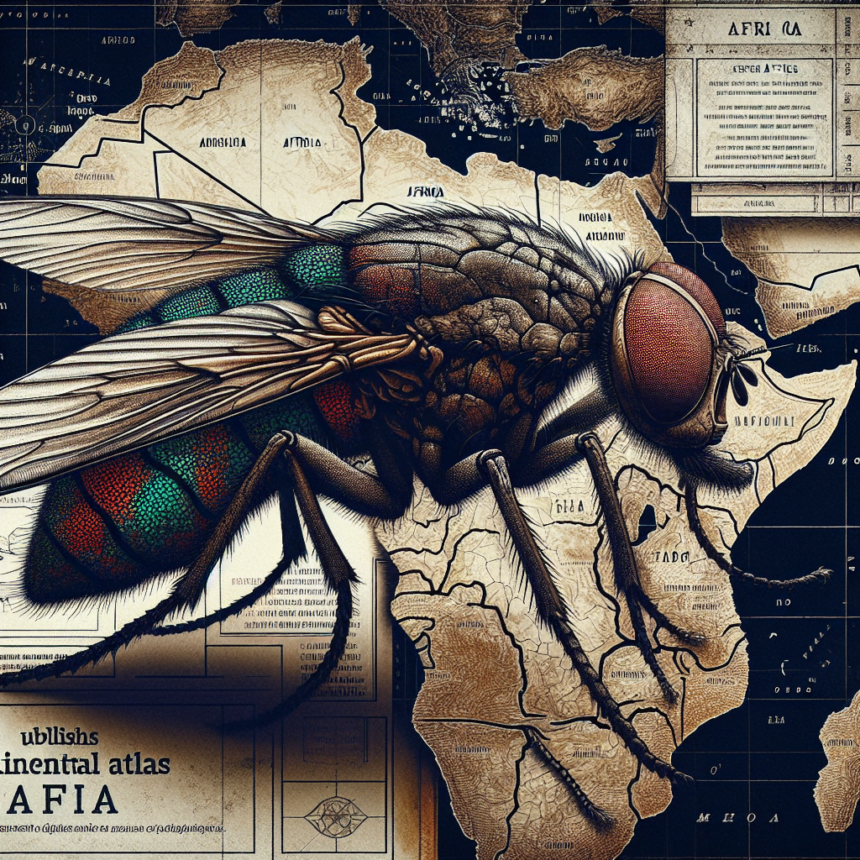Main Points In Hindi (मुख्य बातें – हिंदी में)
-
त्सेत्से मक्खियों और ट्रिपैनोसोमोसिस: त्सेत्से मक्खियाँ (जीनस ग्लोसिना) रक्त चूसने वाले कीड़े हैं जो ट्रिपैनोसोम्स के वाहक होते हैं, जो "स्लीपिंग सिकनेस" (मनुष्यों में) और "नागाना" (पशुओं में) जैसी गंभीर बीमारियों का कारण बनते हैं। ये बीमारियाँ अफ्रीका के किसानों के लिए आर्थिक रूप से तबाही ला रही हैं, जिससे खाद्य असुरक्षा और आय में कमी हो रही है।
-
एफएओ का एटलस और डेटा संग्रह: संयुक्त राष्ट्र के खाद्य एवं कृषि संगठन (एफएओ) ने अफ्रीका में त्सेत्से मक्खियों के वितरण का एक महाद्वीपीय एटलस तैयार किया है, जो 1990 से 2020 तक 669 वैज्ञानिक पत्रों के डेटा पर आधारित है। यह एटलस त्सेत्से मक्खियों के वितरण पर अब तक का सबसे व्यापक मानचित्र है।
-
महत्वपूर्ण प्रजातियों का डेटा: एटलस में त्सेत्से मक्खियों की 31 मान्यता प्राप्त प्रजातियों में से 26 के लिए महाद्वीपीय और राष्ट्रीय मानचित्र विकसित किए गए हैं। इसमें पशु चिकित्सा और सार्वजनिक स्वास्थ्य के संदर्भ में सर्वाधिक महत्वपूर्ण प्रजातियों के लिए प्रचुर डेटा उपलब्ध है, जो प्रभावित देशों में नीति निर्माताओं और चिकित्सकों के लिए उपयोगी होगा।
-
भविष्य की योजनाएँ: एफएओ ने इस एटलस को अद्यतन करने की योजना बनाई है और अन्य महत्वपूर्ण डेटा अंतराल को भरने के लिए एक नया प्रकाशन लाने का भी इरादा है। यह कार्यक्रम अफ्रीकी ट्रिपैनोसोमोसिस के खिलाफ उठाए गए कदमों का एक हिस्सा है और इसमें विभिन्न अंतर्राष्ट्रीय संगठनों की वित्तीय सहायता शामिल है।
- सतत विकास में योगदान: एफएओ के पशु उत्पादन एवं स्वास्थ्य प्रभाग के निदेशक ने आशा व्यक्त की है कि यह एटलस अफ्रीका में सतत विकास के लिए महत्वपूर्ण बाधाओं को दूर करने में मदद करेगा, जिससे गरीबी और भूख से मुक्ति के एक स्वस्थ विश्व के निर्माण में योगदान मिलेगा।
Main Points In English(मुख्य बातें – अंग्रेज़ी में)
Here are the main points from the provided text:
-
FAO’s Continental Atlas: The Food and Agriculture Organization (FAO) has released a Continental Atlas of the distribution of tsetse flies in Africa, which is a crucial tool for combating a parasitic disease that causes significant economic losses for farmers in sub-Saharan Africa.
-
Impact of Tsetse Flies and Trypanosomiasis: Tsetse flies (genus Glossina) are carriers of trypanosomes, single-celled parasites responsible for diseases like "sleeping sickness" in humans and "nagana" in animals, leading to reduced livestock productivity, food insecurity, and income loss for millions of African farmers.
-
Data Collection and Findings: The atlas is based on data from 669 scientific papers covering 31 years (1990-2020) and provides the most comprehensive map of tsetse fly distribution across Africa, confirming the presence of Glossina species in 34 countries.
-
Significance of the Atlas: The collected data will aid veterinary practitioners and policymakers in affected countries and assist international organizations like the WHO in the fight against sleeping sickness and animal trypanosomiasis.
- Future Steps: The FAO plans to update the atlas and develop another publication to address significant data gaps regarding continental maps of animal trypanosomiasis, with support from various international partners.


Complete News In Hindi(पूरी खबर – हिंदी में)
संयुक्त राष्ट्र के खाद्य एवं कृषि संगठन (एफएओ) ने हाल ही में अफ्रीका में त्सेत्से मक्खियों के वितरण का एक महाद्वीपीय एटलस जारी किया है। यह एटलस उप-सहारा अफ्रीका में पशुओं में होने वाली एक घातक परजीवी बीमारी से निपटने के लिए एक महत्वपूर्ण उपकरण है, जो लाखों किसानों के लिए आर्थिक नुकसान का कारण बनती है। त्सेत्से मक्खियाँ (ग्लोसिना जीनस) रक्त चूसने वाले कीड़े हैं और ट्रिपैनोसोम्स के लिए इनक्यूबेटर और वाहक के रूप में कार्य करती हैं। यह एकल-कोशिका वाले परजीवी होते हैं जो त्रिपानसोमोसिस नामक रोग का कारण बनते हैं, जिसे “स्लीपिंग सिकनेस” कहा जाता है। यह बीमारी तंत्रिका तंत्र को प्रभावित कर दर्दनाक लक्षणों का कारण बन सकती है और अगर इसका सही तरीके से उपचार नहीं किया जाए, तो यह मृत्यु का कारण बन सकती है।
हालांकि स्लीपिंग सिकनेस को अब सार्वजनिक स्वास्थ्य समस्या नहीं माना जाता, फिर भी अफ्रीका में यह पशुधन को गंभीर रूप से प्रभावित करती है। पशुओं में होने वाली ट्रिपैनोसोमोसिस, जिसे नागाना के नाम से जाना जाता है, दूध और मांस उत्पादन के लिए हानिकारक है, जिससे खाद्य असुरक्षा और किसानों की आय में कमी होती है। इस क्रम में, पशु ट्रिपैनोसोमोसिस के नियंत्रण के लिए ठोस प्रमाण आधारित निर्णय लेने की आवश्यकता है। हाल ही के वर्षों में, एफएओ ने त्सेत्से वितरण का एक विस्तृत एटलस तैयार किया है, जो ऐसे डेटा अंतराल को भरने की दिशा में एक महत्वपूर्ण कदम है।
इस एटलस के लिए 1990 से 2020 के बीच 669 वैज्ञानिक पत्रों के डेटा का उपयोग किया गया है। इसमें विभिन्न भूगोलिक डेटा का उपयोग करते हुए त्सेत्से मक्खियों के 7,386 स्थलों का विश्लेषण किया गया, जिससे महाद्वीप पर त्सेत्से मक्खियों के वितरण का एक व्यापक मानचित्र निर्मित हुआ। इस अध्ययन में ग्लोसिना प्रजातियों की उपस्थिति को 34 देशों में पुष्टि की गई, जो सेनेगल के नियायेस क्षेत्र से लेकर दक्षिण अफ्रीका के क्वाज़ुलु-नताल प्रांत तक फैली हुई है। हालांकि, कुछ देशों जैसे बुरुंडी, गिनी-बिसाऊ, लाइबेरिया, सिएरा लियोन और सोमालिया के लिए कोई डेटा उपलब्ध नहीं था, और अन्य देशों के लिए सीमित जानकारी प्राप्त हुई।
एफएओ ने त्सेत्से मक्खियों की 31 मान्यता प्राप्त प्रजातियों और उप-प्रजातियों में से 26 के लिए मानचित्र विकसित किए हैं। यह डेटा प्रभावित देशों के लिए नीतिगत निर्णय लेने में मदद करेगा, साथ ही वैज्ञानिक शोधकर्ताओं और अंतरराष्ट्रीय संगठनों के लिए भी उपयोगी होगा। एटलस राष्ट्रीय सूचना प्रणालियों के विकास का एक ढांचा भी प्रदान करता है।
एफएओ के पशु उत्पादन एवं स्वास्थ्य प्रभाग के निदेशक थानावत तिएनसिन ने इस एटलस के महत्व पर जोर दिया है और इसका उपयोग अफ्रीका में सतत विकास के लिए की जाने वाली पहलों में योगदान देगा। आगे की योजना में, एटलस को अद्यतन करने और पशु ट्रिपैनोसोमोसिस के महाद्वीपीय मानचित्र के लिए नए डेटा अंतराल को भरने का कार्य किया जाएगा।


यह एटलस एफएओ द्वारा अफ्रीकी ट्रिपैनोसोमोसिस के विरुद्ध कार्यक्रम के तहत विकसित किया गया है, जिसमें एफएओ के साथ-साथ इटली सरकार, यूरोपीय संघ और विश्व स्वास्थ्य संगठन द्वारा वित्तीय सहायता प्राप्त हुई है।
इस प्रकार, एफएओ द्वारा तैयार किया गया त्सेत्से मक्खियों का महाद्वीपीय एटलस न केवल अधिकारियों और नीति निर्माताओं के लिए, बल्कि शोधकर्ताओं और प्रभावित समुदायों के लिए भी एक अति महत्वपूर्ण संसाधन साबित होगा। इसके माध्यम से वे ट्रिपैनोसोमोसिस के प्रभाव को नियंत्रित करने, रोकने और अंततः समाप्त करने के लिए आवश्यक उपाय कर सकेंगे।
Complete News In English(पूरी खबर – अंग्रेज़ी में)
The Food and Agriculture Organization (FAO) of the United Nations has released a continental atlas detailing the distribution of tsetse flies in Africa. This atlas serves as a crucial tool in combating a parasitic disease that frequently proves fatal to livestock, causing billions of dollars in economic losses for farmers in sub-Saharan Africa.
Tsetse flies (genus Glossina) are blood-feeding insects that act as incubators and vectors for trypanosomes, single-celled parasites responsible for debilitating and often fatal diseases. In humans, this disease is known as “sleeping sickness,” which affects the nervous system and manifests symptoms like fatigue, severe headaches, and coma. If untreated, sleeping sickness can almost always lead to death. While it is no longer considered a major public health issue, with less than 2,000 new human cases reported annually, the disease severely affects livestock in Africa.
Animal trypanosomiasis, referred to as “nagana” in livestock, hinders milk and meat production and the working capacity of animals, leading to food insecurity and reduced income for millions of African farmers reliant on livestock.
Efforts to control and eliminate animal trypanosomiasis require evidence-based decision-making. However, the last continent-wide mapping of tsetse distribution in Africa was developed over fifty years ago, and no Africa-wide map of the incidence of animal trypanosomiasis has been produced.
The FAO atlas fills this data gap and represents a significant step forward. It is based on data collected from 669 scientific papers spanning 31 years (1990-2020). The information combines geographical location data, similar to Google Earth, with entomological fieldwork, which includes stationary traps and fly rounds using mobile devices.
Overall, 7,386 locations were analyzed, creating the most comprehensive maps of tsetse fly distribution in Africa to date. The collected data confirmed the presence of Glossina species in 34 countries, ranging from Northern Senegal (approximately 15 degrees North) to Southern Africa (Kwazulu-Natal province at 28.5 degrees South). However, for five sub-Saharan African nations known to be affected—Burundi, Guinea-Bissau, Liberia, Sierra Leone, and Somalia—no published data was found. Additionally, limited information was available for countries like Angola, the Democratic Republic of Congo, and South Sudan. The atlas did not include North African countries that have historically been tsetse-free.
Relatively abundant data existed for the species of highest veterinary and public health importance, particularly those in the river (palpalis) and savannah (morsitans) groups. However, there was more limited information available for the forest (fuscipes) group. Based on available data, the FAO developed continental and national maps for 26 out of the 31 recognized species and subspecies of tsetse flies. The most widespread species include Glossina palpalis and Glossina tachinoides in West Africa, Glossina fuscipes in Central Africa, and Glossina morsitans and Glossina pallidipus in Eastern and Southern Africa.
This data will be significant for ground-level practitioners and policymakers in affected countries, as well as for scientific researchers and international organizations such as the World Health Organization (WHO), with which the FAO is collaborating in the fight against sleeping sickness. The atlas also provides a framework for the development of national information systems. Under FAO support, veterinary officials in Burkina Faso, Ethiopia, Ghana, Kenya, Mali, Sudan, and Zimbabwe have already adopted the FAO’s methodological approach.
According to Thanawat Tiengshun, Director of FAO’s Animal Production and Health Division, the hope is that these tools will rejuvenate initiatives aimed at overcoming this major barrier to sustainable development in Africa, thus contributing to building a healthier world free from poverty and hunger.
Looking ahead, the atlas was developed under the framework of the FAO’s programme against African trypanosomiasis (PAAT), with financial support from the Italian government, the European Union, and the World Health Organization. Plans are in place for updating the atlas and producing new publications to fill other significant data gaps, including continental maps of animal trypanosomiasis.
Source link








